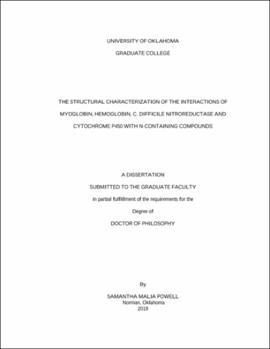| dc.description.abstract | The overall goal of my work was to probe the structural biology of drug metabolite protein interactions and to correlate this with the negative side effects associated with many prescription drugs. More specifically, the focus was on the interactions of myoglobin (Mb), hemoglobin (Hb), a Clostridioides difficile nitroreductase (NR), and cytochrome P450 BM3-HD with N-containing compounds. Using a combination of spectroscopy and X-ray crystallography, I was able to accomplish this goal.
In Chapter 2, the focus was on the formation of heme-nitroso adducts of Mb and Hb generated through oxidative and reductive pathways. While I initially predicted that heme-nitroso adducts would result from the reaction of Mb and Hb with nitro- and hydroxylamine-containing compounds, what actually resulted was the determination of a variety of products in addition to the predicted N-bound nitroso adducts. X-ray crystal structures of these products revealed that some of the compounds evaluated can indeed damage Hb through the formation of hemichromes that can be correlated with early stages of heme loss, which, downstream, may cause anemia. Additionally, we observed, for the first time, that two of the compounds evaluated are capable of S-nitrosating Hb at the betaCys93 residue, an important contributor to the transportation of NO throughout the body. And finally, one of the X-ray crystal structures displays a ligand trapped in a Xe pocket, further demonstrating how large ligands can travel through the pockets within both Mb and Hb to reach the heme active site. The work presented in this chapter thus demonstrates a wide range of products that can result from the reaction of Mb and Hb with nitro- and hydroxylamine-containing compounds.
In Chapter 3, the focus was on C. difficile NRs responsible for metabolizing the antibiotic Mtz. Using UV-vis spectroscopy, I confirmed that a putative NR from C. difficile does in fact function as a Type I NR. Additionally, I solved its X-ray crystal structure, one of the first two reported from the hypervirulent C. difficile strain. The X-ray crystal structure also revealed a putative binding site for Mtz. The work in this chapter provides one of the first expression, purification, characterization and crystallization of a NR from the hypervirulent C. difficile strain.
The focus of Chapter 4 was on the interaction of cytochrome P450 BM3-HD with RNOs, imidazoles and arylhydrazines. Using spectroscopy, I showed that the interaction of RNOs with P450 BM3-HD result in N-bound products and the extent of product formation was dependent on alkyl group size. Imidazoles were found to bind through their N-atoms in a type II fashion. And finally, arylhydrazines were observed to initially bind in a type II manner, but with exposure to air, they formed sigma-bonded aryl-iron complexes. The work in this chapter elucidates the identity of the products in the reaction of P450 BM3-HD with RNOs, imidazoles and arylhydrazines.
Together, the work presented in Chapters 2-4, shows how N-containing compounds and their metabolites interact with Mb, Hb, NRs and P450 BM3-HD. | en_US |

